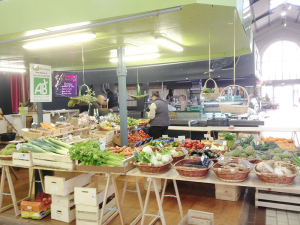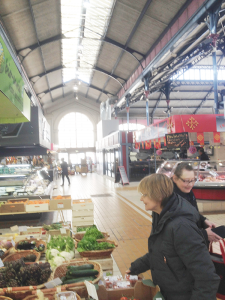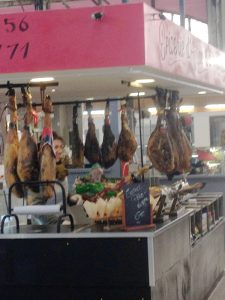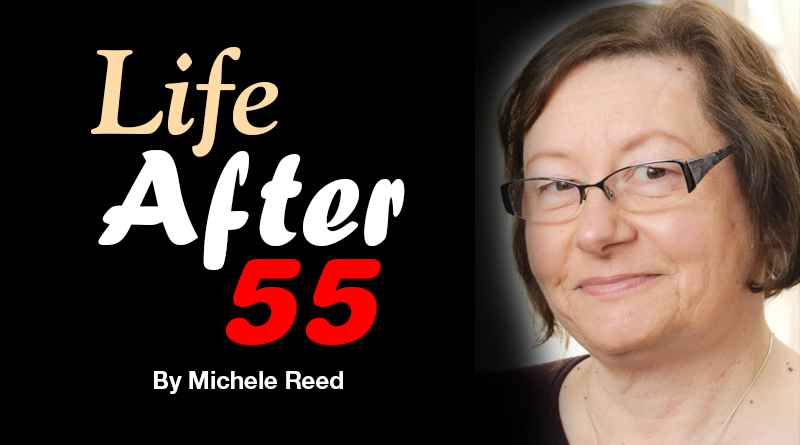In the Market for Good Food
By Michele Reed
michele@cny55.com

Photo by Bill Reed
When we were looking at houses in the South of France, I made a list of must-haves for the village we would settle in. It would have to be on the bus line, preferably on a train line, have a café and restaurants, shops, especially a bakery, and most important on my list: a farmer’s market — or marché as it is known.
In Argeles we had two markets a week: Wednesday and Saturday mornings. More than 20 sellers came to every market, and many times we would have 30 or more, many from Spain. They sold everything — there were several vegetable sellers, three olive vendors, two or three cheese sellers, butchers and people selling ready made food. You could get honey, baked goods, fruit, walnuts, spices and artisanal soaps. We had vendors selling everything from boxers and briefs to mattresses to used books. Sweaters, scarves, purses and PJs were on offer.
It was a typical market day when I would come back with avocados from Spain, selling at five for just 2 euros, olives and olive oil, veggies of all kinds, succulent clementines and a jar or two of honey. The honey seller was a favorite of ours. I would try several varieties before making my purchase and by the end of our stay had bought a bottle of every kind he sold, along with a few of his homemade confitures or jams. He loved to practice his English and Bill, my husband, would talk rugby with him during the Six Nations tournament.
An English lady who lived in Ceret sold her baked goods, including some of the best brownies ever and during the Christmas season, her mother’s pudding and fruitcake. We had many a Saturday lunch consisting of her pasties or meat-filled pies made popular in Wales.

Well, when we found our home in Corneilhan, I pulled out the checklist and had Bérangère, our Realtor, go through it with me: bus stop? Yes, right at the foot of our street. Check. Café? Ditto, although they sold no food, just drinks. Restaurant? Yes, a gourmet pizza parlor, winner of international awards. Shops? Yes, a butcher, an epicerie or little grocery store with a selection of almost anything you would need, and best of all a boulangerie or bakery three doors down. I roll out of bed and have my daily baguette in five minutes flat. Market? Well… during the summer, we have two garages, where people sell vegetables. I had my doubts about that, but once summer came I was thrilled with the “garage” just one block over. The lady who ran it was very nice and her vegetables were freshly picked at local farms. Her mother made wonderful jam and turned out to be our neighbor down the street and especially cordial. Seeing my initial doubts, Bérangère hastened to add, “Of course you can always go to Beziers.” I must have looked horrified. Ride the bus to the big city just to buy vegetables?
As we would soon discover the “big city” of 70,000 is three miles away, easy to navigate and the bus, which costs 30 cents, is a 10-minute ride in the air-conditioned comfort of a well-appointed Mercedes Benz coach. By contrast, at home, we regularly drive 12 miles to Oswego or 28 miles to Syracuse to shop for groceries and other needs, spending about $60 per week in gas.
Before the end of our first week in our new home, we set out to explore Beziers . After exploring the Church of the Madeleine (more about that in another column), we looked across the square and spied a large building, at that time festooned with scenes of bullfighting to advertise the upcoming Feria. It was a huge 19th-century structure of brick, iron and glass, putting us mind of the Bouqueria and Born markets in Barcelona. We headed over to explore and discovered it was Les Halles Centrales, literally the central halls, a marvelous indoor market.
The first stall we encountered was a “bio” (short for biologique or organic) vegetable seller. In addition to fresh lettuces, tomatoes, eggplants and garlic, they had organic honey, spices, rices and even packaged goods like snack chips and cookies.
Then we wandered over to a cheese stall, of which there are two. What would become our favorite, Selvo, is one of the top 100 cheese sellers in France. An unbelievable variety beckoned. Soft cheese, hard cheese, cheeses from the milk of cows, goats and sheep, varieties from France, Spain and Italy. OK, I was officially in cheese-lovers’ heaven.

Three butchers were setting out meats including whole rabbits, chickens and geese. Charcuterie like sausages and hams hung in tempting displays.
A spice merchant’s wares sat in open barrels ready to be scooped out in whatever quantity you desire, perfuming the air with cinnamon, cardamom, rosemary and thyme. He sold olives and tapenades, as well as dried fruits — bright green slices of kiwi, blazing orange apricots and crisp banana chips.
At the opposite end of the Halles was an olive seller with huge bins of olives and tapenades, bottles of fresh pressed olive oils, and local wines, vinegars and mustards. We stocked up on his beautiful tapenades including one made of green olives with paprika from Spain and the beautiful large sweet green olives called luque, our local variety.
Les Halles would become a twice-weekly tradition for us, as we loaded our market basket with all the things that make France a haven for gourmets, then hopped the bus for the short ride back home.
Michele Reed retired after a career spanning four decades in public relations, advertising, journalism and higher education. She now writes travel articles, book reviews, haiku poetry and fiction. Bill Reed retired after four decades in social services with the county of Oswego, and now works at travel photography and photojournalism, along with writing book reviews.

